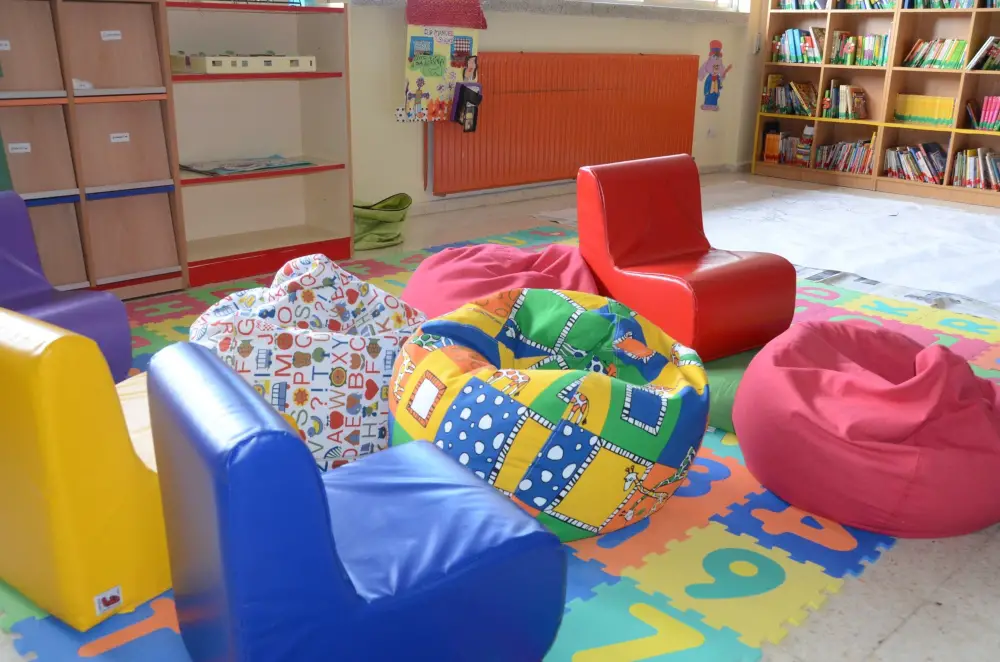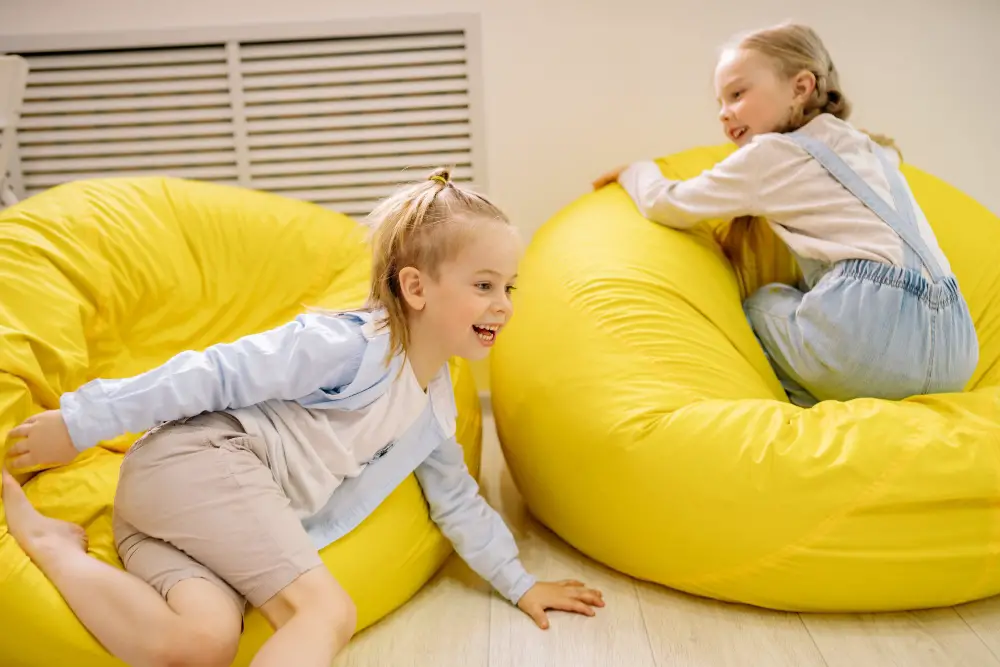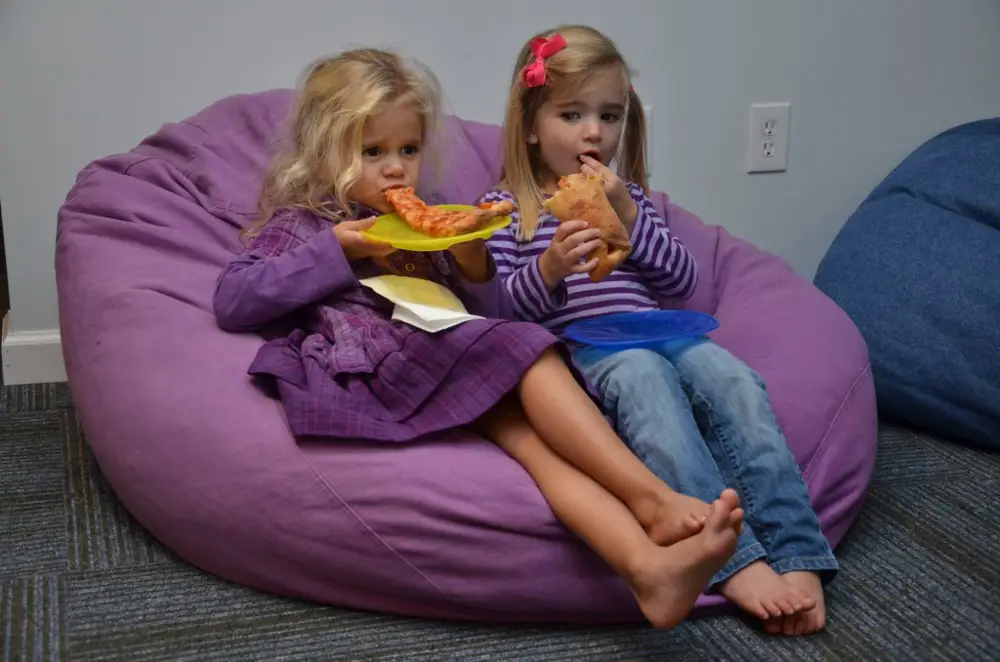Crafting a DIY bean bag chair for kids is a rewarding project. It combines creativity with practical skills. This guide provides step-by-step instructions to create a comfortable, safe, and durable bean bag chair. Perfect for reading nooks, play areas, or indoor playhouses, this DIY project is cost-effective and a great way to add a personal touch to your child’s space.
Contents
Safety First on DIY Bean Bag Chairs
When crafting a DIY bean bag chair for kids, safety is paramount. This part of the guide emphasizes creating a secure, kid-friendly bean bag chair. We focus on durability and design considerations that cater to children’s unique needs. Ensuring the chair’s safety isn’t just about the materials used; it’s about thoughtful design and construction.
Ensuring Durability
- Durability of Fabrics: Choose fabrics that are soft, comfortable, robust, and tear-resistant for your DIY bean bag chair. Materials like heavy-duty cotton, denim, or canvas are ideal. They withstand rough use and frequent washing, which is essential for any kid’s furniture.
- Strong Seams: The seams are the backbone of your DIY bean bag chair. Double stitching or using a serger ensures the seams can handle the weight and movement of children. Reinforce areas that will bear the most stress, like corners and closures.
- Secure Closures: Opt for child-safe closures, like heavy-duty zippers with a safety latch or Velcro for your DIY bean bag chair. This prevents accidental opening of the bean bag and potential filling spillage.
Child-Friendly Design Considerations
- Appropriate Size and Shape: Consider the age and size of the child who will use your DIY bean bag chair. A smaller, rounded shape might suit toddlers, providing a snugger and a safer sitting area. For older kids, larger, more versatile designs might be preferred.
- Non-toxic Materials: Ensure all materials, including the fabric, thread, and filling, are non-toxic and free from harmful chemicals for your DIY bean bag chair. This is crucial as kids may spend a lot of time on the bean bag, and younger children might put parts of it in their mouths.
- Stable Base: A flat and wide base helps prevent the DIY bean bag chair from tipping over when the child climbs or sits on it. This enhances the overall safety of the chair.
- Avoid Small Parts: Avoid designs with small parts to your DIY bean bag chair like buttons or beads, especially for younger children. These can pose choking hazards.
- Maintenance and Care: Easy maintenance is key to ensuring long-term safety of your DIY bean bag chair. Opt for machine-washable materials and covers that can be easily removed for cleaning. Regularly inspect the chair for wear and tear, especially around seams and closures.

Gathering Materials for DIY Bean Bag Chairs
The first step in creating a DIY bean bag chair for kids is to gather all the necessary materials. Selecting the right materials is crucial to ensure comfort, durability, and safety. This section outlines each material you will need and explains their benefits. From the right fabric to the perfect filling, every component plays a vital role in the success of your project.
Fabrics
- Cotton: Cotton is a popular choice in making DIY bean bag chairs due to its softness and breathability. It’s gentle on the skin, making it ideal for children. Cotton is also durable and easy to clean, essential for any item meant for kids.
- Canvas: If you want something sturdier, canvas is a great option for your DIY bean bag chair. It’s highly durable and can withstand many wear and tear, perfect for a playroom setting.
- Denim: Denim is another robust material that can endure a lot of use. Its texture provides a unique feel, and it gets softer with age and use.
- Microfiber: For a more plush feel, consider microfiber. It’s stain-resistant and easy to clean, plus it has a cozy, soft texture that kids will love.
- Velvet: Velvet is a luxurious choice with rich texture and appearance. It’s soft to the touch, making it very comfortable for children. It’s also quite durable, though it may require more careful cleaning.
- Faux Fur: Faux fur can create a playful and cozy bean bag chair. It’s extremely soft and can add a unique style to a child’s room. However, it requires gentle cleaning to maintain its texture.
- Outdoor Fabric: If the bean bag chair will be used outdoors or in a high-use area, outdoor fabric is an excellent choice. It’s designed to withstand elements and is often water and stain-resistant.
- Corduroy: Corduroy is a textured fabric that’s durable and comfortable. It adds a unique visual and tactile element to the bean bag chair.
Fillings
- Polystyrene Beads: Polystyrene materials are the most common fillings for DIY bean bag chairs. They’re lightweight, allowing the chair to mold to the child’s body shape. They also provide good support and are relatively inexpensive.
- Foam: Foam chunks or memory foam offer a firmer feel. Unlike polystyrene beads that can compress, they provide excellent support and hold their shape well over time.
- Natural Fillers: Natural fillers like dried beans or rice can be used as a more eco-friendly option. They are heavier, providing a more grounded feeling but might not be as comfortable as polystyrene or foam.
- Recycled Polystyrene Beads: For an environmentally friendly option, consider recycled polystyrene beads to your DIY bean bag chair. They offer the same benefits as new beads but are more sustainable.
- Buckwheat Hulls: Buckwheat hulls provide a more organic feel to your DIY bean bag chair. They are firmer than traditional fillers and can conform well to body shape, offering good support.
- Textile Scraps: These can be repurposed as bean bag filling if you have old clothes or fabric remnants. This is an eco-friendly and cost-effective option, though it may not be as uniform in texture as other fillers.
- Air Soft Pellets: Lightweight and smooth, air-soft pellets can be used for a softer, more cushion-like feel. They are also fairly durable and hold up well over time.
Other Essential Supplies
- Thread: A durable thread is essential for keeping the seams intact. Opt for heavy-duty threads that can withstand the weight and movement of kids.
- Zippers or Velcro: Choose heavy-duty zippers or strong Velcro for secure closures to your DIY bean bag chair. This ensures the filling stays inside, maintaining the chair’s shape and safety.
- Sewing Machine: A good sewing machine can make the process easier and faster, especially for creating strong, durable seams for your DIY bean bag chair.
- Measuring Tape and Scissors: Accurate measurements and clean cuts are essential for a well-made DIY bean bag chair, so quality measuring tape and sharp scissors are necessary.

Designing Your Bean Bag Chair
The design phase is where creativity meets practicality. This section will explore how to customize the DIY bean bag chair to fit the child’s needs and your aesthetic preferences. From selecting the size and shape to choosing the right colors and patterns, this process allows you to personalize the bean bag chair.
Deciding on Size and Shape
Choosing the right size and shape for your DIY bean bag chair is crucial. It influences not just the look but also the comfort and functionality of the chair, especially when tailored to the child’s age and size.
Smaller, more rounded DIY bean bag chairs are advisable for toddlers and younger children. They’re easier to climb onto and less likely to tip over, making them safer. These chairs can be shaped like animals or simple circles, adding fun to the child’s room.
For older children, consider a DIY bean bag chair with larger, pear-shaped, or teardrop designs. These provide more back support, perfect for reading or gaming. They can also double as lounging spots for teens.
When determining the size of your DIY bean bag chair, it’s essential to consider the available space in your home. A bean bag chair should provide ample seating without overwhelming the room.
Choosing the Right Fabric
The fabric of your bean bag chair is its appearance, comfort, and durability. Consider the child’s preferences and the chair’s intended use when selecting a fabric.
Fabrics like microfiber, velvet, or faux fur are excellent for a cozy, warm feel. They’re soft to the touch and make the chair inviting. If the chair will be used frequently or in a playroom, opt for more durable fabrics like canvas, denim, or outdoor fabric.
In terms of aesthetics, the fabric should complement the room’s decor. Bright colors or bold patterns can add a playful touch to a child’s room. For a more subdued look, opt for neutral colors or simple patterns.
The choice of fabric also affects maintenance. Removable covers made from machine-washable fabrics are ideal for easy cleaning.
By carefully considering the size, shape, and fabric, you can create a bean bag chair that is not just a piece of furniture but a cherished part of your child’s daily life.

Selecting Colors and Patterns
The choice of colors and patterns can dramatically affect the mood and aesthetic appeal of the bean bag chair. It’s an opportunity to inject personality and fun into a child’s space.
The psychology of color plays a significant role in interior design, especially in children’s rooms. Vibrant colors like red, blue, or green can stimulate the mind and encourage creativity. Soft colors like pastels can create a calming environment. Consider the child’s favorite colors or the color scheme of the room where the bean bag will be placed.
Patterns add a dynamic element to the bean bag chair. Playful designs like stars, animals, or geometric shapes can stimulate a child’s imagination. Stripes or polka dots can suit various decor styles and are timeless. When selecting patterns, consider the scale. Larger patterns can make a bold statement, while smaller patterns tend to be more subtle.
Additional Features and Customizations
Adding extra features to the bean bag chair can enhance its functionality and uniqueness.
- Pockets or Handles: Pockets can be sewn onto the chair for storing books, gadgets, or small toys. Handles can make the chair easier to move around, especially for children.
- Personalization: Using fabric paint or patches, consider adding elements like the child’s name or favorite characters. This personal touch can make the chair feel special.
- Adjustable Fillings: Incorporate a zipper or Velcro closure to adjust the amount of filling. This allows the chair to adapt to the growing needs of the child.
Creating a Template
Creating a template ensures accuracy and symmetry in your DIY bean bag chair.
- Paper Template: Start by drawing your design on large paper. This could be butcher paper or joined-together sheets. The template should reflect the exact size and shape of the desired bean bag chair, including seam allowances.
- Cutting and Assembling Patterns: Once your template is ready, use it to cut your fabric pieces accurately. Remember to cut an additional piece to create a removable cover. Assemble the pieces in order, ensuring all edges and patterns align correctly.

Cutting and Sewing
Your DIY bean bag chair takes shape in the cutting and sewing stage. This section is all about precision and attention to detail. Proper cutting ensures your pieces fit together perfectly, while careful sewing guarantees durability and safety. Whether you’re a seasoned sewer or a beginner, these steps will guide you through creating a well-constructed bean bag chair.
Preparing the Fabric
Before you start cutting, preparing the fabric is crucial for a smooth sewing process. This stage ensures your fabric is clean, wrinkled-free, and cut accurately.
Wash your fabric first to prevent any shrinkage after making the bean bag. Use a gentle cycle and suitable detergent, especially for delicate fabrics like velvet or faux fur.
After washing, thoroughly iron the fabric. This removes any creases or folds that could affect your cutting accuracy. Use the appropriate heat setting for your fabric type to avoid damage.
Lay your fabric flat, and place your template on top. Use tailor’s chalk or a fabric marker to trace around the template. Be sure to mark all seam allowances.
When cutting, use sharp fabric scissors for a clean edge. For curved edges, make small, precise cuts to maintain the shape. Cut out all pieces according to your design, including any extra features like pockets or handles.
Sewing Techniques
Proper sewing techniques are essential for constructing a durable and safe bean bag chair.
Begin by pinning the fabric pieces together, right sides facing each other. Use a sewing machine for a stronger and more uniform seam.
Start with a straight stitch, and remember to backstitch at the beginning and end of each seam to prevent unraveling. Follow the pattern you’ve marked, maintaining a consistent seam allowance.
For a bean bag chair that withstands active use, reinforce your seams. After sewing your initial seam, go back over it with a zigzag stitch or use a serger if you have one.
This not only strengthens the seam but also helps prevent fraying. Pay special attention to areas that will bear the most weight, like the base of the bean bag.
Inserting the Filler Opening
The filler opening is a critical component of your bean bag chair, allowing you to insert and adjust the filling as needed.
Select a closure method that is safe and convenient. Zippers offer a secure closure, but choose a heavy-duty one with a safety latch to prevent accidental opening.
For younger children, Velcro can be a safer option. It’s easier to handle and eliminates the risk of a zipper snagging.
When installing the zipper or Velcro, reinforce the fabric with additional stitching to support the weight of the filling. If using a zipper, sew it onto one of the seam lines, ensuring it’s aligned correctly and lays flat.
For Velcro, sew it along the edge of the opening, making sure the hook and loop pieces align perfectly when closed. Double-check the closure for any gaps or misalignments.

Filling the Bean Bag Chair
Filling your bean bag chair is a pivotal stage where comfort and support come into play. The right filling not only defines the feel of the bean bag but also impacts its longevity and safety. This section guides you through choosing and inserting the filling, ensuring your bean bag chair is as comfortable as it is inviting.
Filling Technique for Optimal Comfort
Properly filling the bean bag chair is key to achieving the ideal balance of comfort and support.
- Calculating the Amount of Filling Needed: Estimate the volume of your bean bag chair and choose the amount of filling accordingly. A fuller bean bag provides more support, while a less filled one will be more slouchy and moldable.
- Inserting the Filling: If using a zipper or Velcro closure, open it and gradually add your filling. It’s easier to manage with a funnel or a makeshift funnel from a piece of cardboard. For a uniform feel, distribute the filling evenly, ensuring it reaches all corners.
- Adjusting the Filling: Sit on the bean bag to test its firmness. Add or remove filling until you achieve your desired level of comfort. Remember, adding more filling later is easier, so start with less and increase as needed.
- Sealing the Bean Bag: Securely close the zipper or Velcro once the filling is adjusted. If using a zipper, ensure the safety latch is engaged to prevent accidental opening.
Safety Considerations
Safety is a critical aspect, especially when dealing with children.
- Preventing Spillage: Ensure your closure is secure to prevent any spillage of the filling, which can be a choking hazard for young children.
- Regular Checks: Periodically check the bean bag for any tears or weak points, especially around the closure. Promptly repair any damages to maintain the safety and integrity of the chair.
- Keeping the Area Clean: Bean bag fillers can be messy, so fill the chair in an area that’s easy to clean, like a tiled floor or outdoors. Clean up any spilled filling immediately to prevent slips or ingestion by pets or young children.

Maintenance and Safety Tips
Proper maintenance and regular safety checks are essential for ensuring your DIY bean bag chair remains a safe and cherished part of your child’s environment. This section focuses on the care and upkeep of the bean bag chair, emphasizing the importance of regular inspections and cleaning to prolong its life and maintain its safety.
Cleaning and Care Instructions
- Regular Cleaning: Follow the washing instructions based on the fabric type for removable covers. Machine wash or hand wash as appropriate, and allow to air dry completely before reusing.
- Spot Cleaning: For non-removable covers, use a mild detergent and a damp cloth for spot cleaning. Avoid harsh chemicals that could damage the fabric or be harmful to children.
- Vacuuming: Periodically vacuum the bean bag chair to remove dust and allergens, especially in the creases and seams.
Regular Safety Checks and Upkeep
- Inspect Seams and Closures: Regularly check the seams and closures for any signs of wear or tear. Repair any loose threads or openings to prevent the filling from escaping.
- Filling Integrity: Over time, certain fillings may compress. Check the firmness of the bean bag chair and add more filling as needed to maintain its shape and comfort.
- Safe Environment: Place the bean bag chair in a safe area, away from sharp objects or extreme heat sources, like radiators or open flames.
Addressing Wear and Tear
- Prompt Repairs: Address any damage as soon as it’s noticed. This includes sewing up small tears or replacing parts of the closure system if they become loose or broken.
- Fabric Protection: Consider using a fabric protector spray to guard against stains and spills, especially for chairs used by younger children.
FAQ on DIY Bean Bag Chairs for Kids
What is the best fabric for a DIY bean bag chair for kids?
Durable and easy-to-clean fabrics like cotton, canvas, denim, and microfiber are excellent choices. Consider the usage and location of the bean bag when choosing the fabric.
How much filling do I need for a bean bag chair?
The filling depends on the size and desired firmness of the bean bag. Start with a smaller amount and add more as needed. You might need around 8-10 cubic feet of filling for a standard-sized bean bag chair.
What type of filling is safest for kids?
Polystyrene beads are commonly used, but ensure they are small enough to not pose a choking hazard. Foam chunks or natural fillers like buckwheat hulls are also safe alternatives.
Can I wash the bean bag chair?
If the cover is removable, you can wash it according to the fabric’s care instructions. For non-removable covers, spot cleaning is recommended.
How do I ensure the bean bag chair is safe for my child?
Use child-safe closures like safety zippers or Velcro. Regularly check for wear and tear, especially around seams and closures. Ensure the chair is free of small, detachable parts that could be a choking hazard.
Can I make a bean bag chair without a sewing machine?
Yes, but it requires more effort. You can hand-stitch the seams, but ensure they are strong and well-sewn to handle wear and tear.
How do I choose the right size and shape for my child’s bean bag chair?
Consider the child’s age and size. Smaller, rounded chairs are better for younger kids, while older children might prefer larger, more supportive designs.
Is it possible to refill the bean bag chair?
Yes, most bean bag chairs can be refilled. Choose a design with a zipper or Velcro closure for easy refilling.
What maintenance does a bean bag chair require?
Regular cleaning, checking for damages, and refilling as needed are key maintenance steps. Use a fabric protector spray for added protection against stains.
Can I customize the bean bag chair?
Absolutely! Personalize with your child’s favorite colors, patterns, or themes. Add features like pockets or personalized embroidery for a unique touch.
Conclusion
Crafting a DIY bean bag chair for kids is an enjoyable and fulfilling project. It allows you to create a unique, comfortable, and safe piece of furniture that your child will love. Following the steps outlined in this guide, you can ensure your DIY bean bag chair is a cozy addition to your child’s space.






